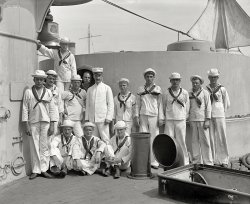
MAY CONTAIN NUTS

Search Shorpy
SHORPY ART

Framed or unframed, desk size to sofa size, printed by us in Arizona and Alabama since 2007. Explore now.
Join and Share
Ad-Free Shorpy
Shorpy is funded by you. Patreon contributors get an ad-free experience.
Learn more.

Recent comments
- Say what??
- Grapes?!
- A Beautiful Moment
- Such joy
- Bethune-Cookman University today...
- Yellow sky at morning
- Side Winder
- Air Quality?
- Sojourner Truth riot
- None were so blind(ed)
- The less famous sister
- Good ol' days?
- Rise and Fall
- Goo Goo Ga Joob
- Ticket Retention
- Not the only one
- Vagaries of War
- Killed by Amtrak
- Back to the Future
- Wanted --
- If you can't stand the light
- Centralized Traffic Control, I believe
- What's really happening
- Heckuva remote control!
- Sometimes — Things Go Bump!
- I SEE THE LIGHT
- Union Switch and Signal Company
- Get That Light Out Of My Eyes
- Eggs. Eggs. Eggs. The Egg Man is Here!
- Foreboding caption
Member Photos
The Shorpy
Print Emporium
Print Emporium
Search Shorpy
Search results -- 30 results per page
- Vacation Wagon: 1964
- ... my father, was driving Volkswagen Beetles. (He later had a new Ford Mustang 1964 1/2 , with a 289 ci V8 and a four speed box, rally pack ... we got in our in our '53 Chevy coupe and went from New York City to the SF Bay Area, mostly along US 40. Entertainment consisted of ... Posted by Dave - 05/31/2022 - 1:09am -
![Vacation Wagon: 1964 Our annual salute to the start of vacation road-trip season, first posted here 15 years ago. Everyone buckled in? Let's go!
"Great Falls, Montana. Return after 3 weeks Vacation. June 27, 1964." This Kodachrome of a 1960 Chevrolet Parkwood station wagon is from a box of slides found on eBay. View full size.
family trips in those carsI also spent some hot days in a car like that on the way to the grandparents. My mother flattened the second seat, put a mattress on the floor and loaded three of us and the stuff in on top of it, us and the stuff equally loose and not tied down. We whined and fought and slept our way to Cape Cod from southern NJ. My father always "had to work" (they were her parents), so she did the drive alone, I think maybe 12 or 16 hours? Seemed like forever.
NostalgicThese people still had a bright future ahead of them, full of great hopes for the days to come. They hadn't gone to the Moon yet, and to them, by 2007 we'd have personal helicopters and robots would run everything. The possibility of the President being indicted for a crime was unthinkable. My job as a web designer hadn't even been invented yet.
The lawn looks like it's literally astroturf. Were the colors really like that, or is it an effect of the kodachrome?
Holy cow! We had a 59 chevyHoly cow! We had a 59 chevy stationwagon back in the day. Does this bring back memories. We would drive to Florida from Virginia a two day trip usually in the heat of the summer to visit grandparents. Five children two parents no ac. Damn!
[This is a 1960 Chevrolet. - Dave]
DeflectorsDoes anybody know/remember what the deflectors left and right of the rear window were for? These may have been an aftermarket item.
It is amazing how well the colors in this slide are preserved after almost 50 years. It looks like Kodachrome all right, including the telltale blue cast in the shadows
The Astroturf look......to my eye, seems to come from the little flowers (or toadstools?) that are in the lawn. At the smaller image size, they look like specular reflections, making it seem like the grass is shiny.
[The white flowers are clover. - Dave]
1964As I remember it, this was less than a year after the assassination of JFK, there were race riots in the south and we (I was 14) were all starting to question attitudes towards women, blacks, hispanics, homosexuals and the culture we had grown up with. One of the more minor cultural things was the importance of your front lawn.
50 years?I was born in 1964, and trust me, it hasn't been 50 years since then, yet.... ;)
Re:DeflectorsThe deflectors on either side of the rear window were intended to blow air across the rear window to prevent snow from accumulating. A similar deflector is often fitted along the roof on station wagons from the 60s on. I think they were usually a factory or dealer option in later years, but I really don't know specifically about this model or when they might have first been used.
OK, 40 years.Sorry, I was too vexed on the year of manufacture of the car.
I remember that someone in our street had the sedan version of this Chevy. Like any 8 year old, I was fascinated by the winged tail and the panorama windshield. You didn't see many of these in Europe around 1960; everbody, including my father, was driving Volkswagen Beetles. (He later had a new Ford Mustang 1964 1/2 , with a 289 ci V8 and a four speed box, rally pack and (optional) front discs, which I found very impressive at the time. A real gas guzzler by European standards.
Family TrucksterThis is probably what Clark Griswold's dad took the family on vacation in. It's a 1960 Chevy, and I'm guessing it's a Kingswood model. The Brookwood was the more stripped down model and I think the "full dresser" was called a Nomad. This one isn't completely chromed-out and it has the small, dog-dish hubcaps so I'm thinking it's the middle of the line model.
I think the rear air deflectors also helped keep exhaust gas from entering the rear passenger compartment when the vehicle was moving with the tailgate window was lowered. Though it doesn't look like there's room for anybody in the third row of seats for this trip. With the window up they also helped keep the rear glass clear of snow and dust.
These are Parents of the Year......in my book. Can you imagine going across country now without all of the luxuries and Wendy's and portable DVD players and Nintendo and cell phones and credit cards?
These parents did it all the HARD way...and I'll bet they made a lot of memories that summer!
My jaw droppedOnce again the red stationwagon family blows me away. The color composition here is perfect.
Chevy ParkwoodThis is a 1960 Chevrolet Parkwood. Parkwoods and Kingswoods both use Bel Air trim (mid-level). The Kingswood, a nine-passenger wagon, has the third-row rear-facing seat, and two steps on the rear bumper (one on each end just outside of where the tailgate would come down). Less obvious is that all Kingswoods have power tailgate windows, an option on the other Chevrolet wagons.
I still drive a '59 ChevyI recommend owning one. In 2000 We took the ultimate road trip with mine from near the Canadian border in Washington State through the desert to Las Vegas and back up through California and Oregon. There really is nothing like seeing the U.S.A. in your Chevrolet. Cruising the Strip in Vegas was a blast. We might as well have been driving a space ship with the reactions we got. Sadly, these Chevrolets were mostly scrapped and very few survive.
60 ChevySadly, the third row seat had not been invented as of yet and the deflectors were used to deflect air into the rear of the stationwagon at slower speeds. I may not be an expert but I'm old enough to have ridden and slept in the back section of a folded down stationwagon. We didn't know about SUV's yet.
Chevy WagonChevy's Parkwood and Kingswood wagons could both be had with a third-row seat. And back then, for the record - wagons WERE the "SUVs" of the day!
[According to the 1960 Chevrolet sales brochure, only the Kingswood was available with third-row seating. The International Travelall and Chevy Suburban Carryall were two of the SUVs of the day. - Dave]
The luggage rackis something you don't see anymore. It hung on the wall of the garage when not in use. Once my dad, who was in a big hurry, didn't secure the tarp on top properly...
We played car games, like Alphabet, Road Bingo, and License Plates, read books, colored,sang songs and squabbled. You took your chances with local restaurants. We hadn't got used to entertainment on demand, so we didn't miss it.
And to Dave Faris: It's the film. I once assured my daughter that colors when I was a kid were the same as today. "The Fifties," she said, in her narrator's voice, "were an oddly-hued decade."
Slide ConversionHow does one convert slides to digital photos? Any website links or advice?
[You'd use a film scanner. I used a Nikon 4000 ED for this one. - Dave]
Family TrucksterWe had a green Ford station wagon, not nearly as nice as this, and with our family of six, it was a masochistic experience to take family vacations. Every summer we said that's it, we will never do this again, until the following summer when we did it again. The best part was arriving home again, but I will say that NOT having DVD's and high tech electronic gadgets forced the kids to look out the window and they gained incredible geographic knowledge from seeing the U.S. I could truthfully call these annual trips "purgatory on wheels."
Road TripMost all of my long-distance car trips were connected with moving as my father was in the USAF. In August 1954, after being in the UK 2½ years, we got in our in our '53 Chevy coupe and went from New York City to the SF Bay Area, mostly along US 40. Entertainment consisted of looking at the scenery and checking off the towns on the free roadmaps that the service stations provided in each state. Iy being the pre-Interstate era, one did go thru many towns back then! (Excepting on the PA Turnpike) Burma-Shave signs relieved the boredom in the rural areas. We had a car radio (AM only, of course), but for some reason I can only recall it being used while crossing the salt flats west of Salt Lake City.
Westward HoIn 1951 our family, my wife, son and daughter, living in Detroit, started taking trips to Cheney, Washington, to visit my WW2 buddy. All on old state highways, no air conditioner, 4½ hours to get through Chicago and the kids loved it. Took these trips out west to the 1970s. We still go west to see my buddy and my daughter in Seattle and we enjoy crossing Nebraska on old U.S. 30. It is a treat to be off of I-80.
Nostalgia Ain't What it Used to BeDon't look at this picture and pine for the old days.
Change the car to a green Olds Vista Cruiser and that's us in 1969. Back then, dads bought a new station wagon to kick off the summer vacation. Dads don't buy an SUV today for that reason.
Without repeating some of the horrors already mentioned below, there was the additional joy of Mom sending back a Coca Cola bottle for one of her sons to use in lieu of a loo. If the girls had to go, we had to pull over. Not so with the boys.
Watching mom backhand-fling a Coke bottle out her window, filled with fluid far different that what was originally intended, and seeing it bounce and spill along the shoulder as we whizzed along at 75 mph (pun intended), that's about the fondest vacation memory at least from the car perspective.
Today with the daughter hooked up to a video iPod and the sons enjoying their PSP, it's a pleasure to drive for distances. Back then, we didn't play License Plates. We played Punch Buggy and Slug Bug, etc. Fistfight games.
Let's go!I loved car trips, and I never had DVD players and Nintendo. I watched the scenery and kept a travel diary. those were some of the greatest times of my life.
Road TrripWe had to make do with pillows & blankets. A mattress would have made it actually comfortable. I don't know if Dad didn't have the imagination for that, or just not the money. I suspect the latter.
We'd sing sometimes. It was 12 hours from north Georgia near the North Carolina line to south Georgia, near the Florida line, where my grandmother lived.
I see the moon; the moon sees me.
The moon sees the one that I want to see ...
Thanks for the memoriesMy folks had the four-door sedan version of this car, in sky blue & white. My mom used to have a station wagon, don't remember what kind, but it was memorable for its pushbutton transmission on the dash instead of a gearshift! However my favorite "finned" car was our family's Buick Invicta. Now that was a car!
Third Row SeatsFords had third-row seats in 1955. I'm pretty sure Chevy had them by 1958 at least. Chevy didn't offer woodgrain sides until '65.
Sunday ridesWe had that same car, only in light blue.
No seat belts or infant seats for us! We'd put my baby sister in one of those deathtrap baby seats that hooked over the front seat and off we went!
What a picture!This picture takes me back almost 40 years to the road trips our family did during summer holidays when I was a little boy. It feels like I myself am stretching my legs after coming home. The colours, the moment -- one of my favorite pictures in Shorpy.
My Favorite Car was a 1960 Chevrolet Impala 2-dr hardtop. Bluish gray with white segment on the side, red and white interior. The first car my wife and I bought. Paid $1750 for it used in 1962. We made some wonderful trips in that car.
Re: Family TrucksterJust saw this item on TV yesterday about a real family named Griswold that had their station wagon modded to look like the Family Truckster from National Lampoon's Vacation movie for their trip to Disney World.
http://tinyurl.com/plo5kub
See the USA in Your ChevroletFor our family, it was a 1962 Buick Invicta wagon. Huge car designed for doing massive mileage on the interstates and that's what we did -- six or seven hundred miles a day from Indiana to the Rockies for our annual vacation.
Procedure for Accessing the Cargo AreaWe had one of these when I was a kid as well. Ours was a silver gray color. See the chrome disk on the trunk door? Upon arriving at destination, here's what you had to do:
1) Put trunk key in center slot (separate keys for ignition and trunk back then)
2) Open flap (as seen in photo)
3) Rotate flap several times till rear window is fully down
4) Reach in and grab handle to drop tailgate
Simple, huh?
Looking at old red carsmakes my elbows hurt! Seemed like some of those old single stage paints, reds in particular, had to be waxed every two weeks to keep them looking decent. The widespread adoption of clearcoat finishes in the late 80's to mid 90's freed modern kids from the dreaded frequent waxing chore, thereby giving them the leisure time to start the video gaming revolution...
As Long AsThis isn't really the "End of the Road"! That's a scary title for all the Shorpy Faithful.
3 Adults + 7 Children =1000 mile round trip to see grandma.
We kids didn't mind a bit.
Seat belts?I don't think you heard "Everybody all buckled up?" all that much in '64. I'm not sure of the exact dates, but if you had seatbelts back then, you bought them at a discount store or an auto parts store like Western Auto or J. C. Whitney, and they were lap belts only. Three point seat belts didn't come along for several more years, if I recall correctly, and it wasn't until the government mandated new cars with ignition interlocks in the 1970's that "real men" started to actually use them.
Back then, we used to spend our vacations camping, so the car was packed to the gills, including the center of the back seat. My sister and I each got little cubbyholes next to the doors, with just room enough to sit for the trip to northern Wisconsin. My dad drove a two tone green '55 Oldsmobile Delta 88. I saw a picture of that car a few months ago, and as soon as I did, I started remembering a surprising amount of detail about the car's details. It was handed down to me when I went off to college in '64.
Seat beltsbobdog19006 is correct in that seat belts were not standard equipment in 1960. However, they had been available as a dealer-installed option since the 50s. By 1966, they were standard in all Chevys, and by 1968, they were federally mandated.
I spent many a happy hour on family roadtrips in our '68 Ford wagon, nestled in the narrow gap between the second row and the rear-facing third-row seat, no seat belt, of course. Neither did my siblings in the third row.
Service StickersI remember those stickers that service stations or car dealers put on the inside edge of the driver's door when you got your car serviced. This Chevrolet has two.
Our road trip rigWe had a '76 Chevy Beauville van, a ho-hum light brown rather than red, which made up for the lack of chrome spears with its cavernous interior: two bucket seats in front for Mom and Dad, two bench seats, and a homemade plywood bed. Strangely, all that space wasn't enough to prevent sibling quarrels.
The best story of this van was the return trip of its maiden voyage, when my uncle, who owned a small niche-market manufacturing firm, talked my dad into towing a piece of equipment from South Texas to a parking lot near Chicago, where we would deliver it to his customer from Wisconsin. We quickly got used to being asked at every single hotel, gas station, and rest stop, exactly what was the three-wheeled contraption with the hydraulically-actuated vertical roller-chain conveyor with teeth.
The looks on everyone's faces when my dad told them it was a grave-digging machine: Priceless!
Curtains?Every August for years we travelled from Birmingham to Cincinnati for a week of visiting my parents' relatives. Before our last such trip in '69, we went through a black-and-white '57 Plymouth Savoy, a metallic-beige '63 Ford Country Sedan wagon (the one without wood on the sides) and a '67 Olds VistaCruiser. I'd love to have that VistaCruiser back today. Ours was burgundy red and my dad put red stripe Tiger Paw tires on it. Imagine a 442 station wagon.
As for Shorpy's '60 Chevy wagon, I only just noticed the homemade or aftermarket side curtains, with vertical stripes of brown, gold and red to compliment the bright red car.
Thanks, Dave, for showing us this photo again... and including all the original comments, too. Great to relive all the great summer vacation stories with everyone!
Re: deflectorsIn the days before the rear window wiper on a station wagon, some folks put these on and the deflected air current would help to clean off that window to a degree. Not having either, within a mile that rear hatch would be almost impossible to see through. Been there, done that and got the tee-shirt.
This does bring back memoriesWe had a similar station wagon, but it was salmon (or was it mauve, or ecru?) colored with a white top (I think). It had a 460 a/c (four windows down while traveling sixty miles per hour, some times 560 with the rear tailgate window down). I remember taking a trip from Mississippi to Six Flags over Texas on U.S. Highway 82 (two lane most of the way) in Summer, 1964. The back seats were folded down, and the four of us kids had pillows, blankets, books, and board games to pass the time. It was replaced soon after with a 1965 Ford Country Squire Wagon with a/c, and fake wood paneling on the side. Instead of a rear facing bench seat, it had two small seats on either side that faced each each other.
Memories of summer tripsWe also lived in Montana back then, and our family truckster in the 1960s was a 1963 Rambler Classic station wagon. (Yes, I suffered greatly for it among my friends.) That's what I learned to drive, and we ranged all over the western US and Canada in it.
Before that, however, we traveled in a 1949 Studebaker Land Cruiser 4-door sedan, which my dad (both inventive and frugal) had outfitted with a set of three back seats that, when covered with the mattress from our roll-away bed, filled the back seat and trunk area with a very passable sleeping unit. That's where I spent most of my time on our travels. At other times, I would climb over the front seatback into the front bench seat between my parents. That's where I was on August 5, 1962, when we were preparing to leave Crescent City, CA, and heard on the radio that Marilyn Monroe had died.
Deflector's actual purposeWas to break the "vacuum" the "wall" that was the rear of that wagon created which would suck exhaust into the car if that rear window was open even a little bit. The fresh air, the snowless/cleaner rear window were merely bonuses...
Buckle up?A 1960 Chevy wagon probably didn't have seat belts unless the owner installed them. The kids in the back were pretty much free range as long as they didn't make too much noise. Lots of people piled the stuff on the roof and put a mattress in the back for the kids.
It was a great way to go and most of us survived.
[Seat belts were optional on all 1960 Chevrolets. - Dave]
Car playgroundMy folks had a Ford wagon of that era. No seatbelts. Folks put a mattress in the back. Became our playground on long trips. We had no desire to "sit" in a seat.
Miss station wagonsI miss station wagons. I prefer them to the SUVs that replaced them.
I also miss the bold bright colors that cars use to come in.
No SquattingLooking at all the stuff already loaded, I'm surprised the back of this wagon isn't dragging on the ground. In fact it's sitting pretty level. I wonder if dad had overload springs installed?
We've had one built for you.To BillyB: Station wagon suspensions were designed with the idea that they would have to haul some combination of eight people and their luggage, so they did OK when loaded down. They *were* softer than contemporary pickup trucks, so the back end of the station wagon wouldn't bounce all over if there were only one or two people in it. Especially at the time of this photo, gas was 25 cents a gallon and would be that price forever, so the factory didn't mind spending a little extra weight on a beefier suspension.
Also, most of the really heavy luggage went on the roof rack, which was fairly close to being in the middle of the wheelbase. The back-back, behind the rear seat, tended to contain lighter things, like blankets, pillows, the picnic basket, and - as the trip progressed - bags of souvenirs. If Dad wanted to use the inside rear-view mirror, you couldn't stack stuff much higher than the seats, anyway.
Source: I rode in the back of a '79 Oldsmobile wagon every summer from '79 to '87. I think the longest trip we took in it was from Kansas City to Washington, DC and back.
WagonsWe had a 1956 Ford wagon, then '61 Mercury wagon, finally a (I think) 1964 Ford wagon.
I remember one year with the Mercury, my mom ran low on gas. We were up in the mountains in a resort town. To get to the gas station, she had to reverse up hills, turn around for the downhills, turn around again for going up the next hill. What a ride.
Another time, 1965, we were in a typhoon in the current wagon. There were eleven of us in it. Another wild ride driving on a road along the bay. Waves washing over us, my mom hugging the middle of the road (there was an island we could not get across).
Wagons were great.
The 283 V-8with its 170 gross horsepower is not going to have much highway passing reserve with all that weight. Cross-flags over the V on the tailgate would have indicated one of several 348's which would have given more than enough reserve. That car is 58 years old but properly equipped could have kept pace with most cars on the road today in equal comfort. A 58 year old car in 1960 by comparison was barely even recognizable as such it was so rudimentary by comparison to the 1960 version in its looks and capabilities. The same comparisons held true in all other realms of life comparing 1960 to 1902--homes, conveniences, dress, you name it. Virtually any of those later areas are not that significantly different from their 1960 versions.
Those deflectors... were supposed to keep dust off the back window
Nikon CoolscanI am having a problem with mine. Can you recommend a place that can repair them.
[There aren't any. Try buying them used on eBay. - Dave]
283 V8Although I agree that a 348 engine would have been a better choice for this station wagon. The 170hp 283 was the base V8 engine with just a single two barrel carburetor. The next option up was also a 283 but with a four barrel which the above wagon may have had, which would have given it a little more passing power.
Koolscan softwareDave. What software program do you use with your 4000? As it seems the program that came with it is only works for Microsoft VISTA.
[I use the NikonScan software that came with the scanner, on a Windows 10 workstation. To install the software on a modern operating system, you have to disable Driver Signature Enforcement. And it's Coolscan, with a C. - Dave]
(The Gallery, Cars, Trucks, Buses, Kodachromes 1, Travel & Vacation)](https://www.shorpy.com/files/images/vacation_1960s_00.thumbnail.jpg)
- New York Avenue: 1905
- DeLand, Florida, circa 1905. "New York Avenue." Looking a little like New England with palm trees. 8x10 inch glass negative. View full size.
... Posted by Dave - 05/12/2014 - 12:02pm -
![New York Avenue: 1905 DeLand, Florida, circa 1905. "New York Avenue." Looking a little like New England with palm trees. 8x10 inch glass negative. View full size.
Florida FoliageThose appear to be Palmettos.
[The bigger ones (and maybe the others) are young sabal palms -- Florida's state tree. -Dave]
PalmlessI see no palms trees. Who can identify the fronded vegetation?
(The Gallery, DPC, Florida)](https://www.shorpy.com/files/images/SHORPY-4a12558a.thumbnail.jpg)
- Fifth Avenue: 1912
- New York circa 1912. "Fifth Avenue at 42nd Street." At left, the East Coast outlet ... I wonder how many pedestrians were lost on the streets of New York in 1912?
Street Clock at 522 Fifth Ave. Still standing!
... Posted by Dave - 07/10/2018 - 7:58pm -
![Fifth Avenue: 1912 New York circa 1912. "Fifth Avenue at 42nd Street." At left, the East Coast outlet of California's Cawston Ostrich Farm. 5x7 inch glass negative. View full size.
Driving rightI know we've always stayed to the right in the US when traveling down a road, but I wonder when the driving position within the vehicle shifted to the left side? All the drivers in the photo are sitting on the right hand side of their vehicles.
[There was a gradual transition from a mix of left- and right-hand drive cars. By 1920 they were almost all LHD. - Dave]
More dangerous than the TitanicI wonder how many pedestrians were lost on the streets of New York in 1912?
Street Clock at 522 Fifth Ave.Still standing!
Great old time outfits.As long as you like Black.
Early movie of 1911 New York CityIn this speed-corrected early movie with sound added of New York City in 1911, it's amazing how these first people in human history to have access to self-propelled vehicles seem to have so quickly adapted to them without benefit of any rules or traffic lights, both pedestrians and drivers--it's almost like we had some kind of hard-wired affinity for the advent of the automobile. Of course, skill sets in other areas no doubt helped.
https://www.youtube.com/watch?v=aohXOpKtns0
Men in WhiteThe vehicle in the middle of the street heading away from the photographer appears to have a police officer and a Good Humor man in back. Any ideas as to what the vehicle would be used as? Paddy wagon, ambulance or ice cream truck?
[The white suits on New York's streets in photos from this era are generally sweepers with the Department of Sanitation. - Dave]
You couldn't pay me enoughNo sirree, not me. Those two gents in the upper left working
on the sign need hazardous duty pay.
(The Gallery, Cars, Trucks, Buses, DPC, NYC, Stores & Markets)](https://www.shorpy.com/files/images/SHORPY-4a27524a.thumbnail.jpg)
- New York World's Fair 1964
- My sisters with Dad at the 1964 New York World's Fair. View full size.
(ShorpyBlog, Member Gallery, Travel ... Posted by delworthio - 06/26/2008 - 10:33am -
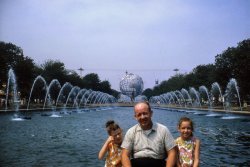
- New York City's Youngest Judge
- ... Leo Healy (center) is installed as the youngest judge in New York City at the age of 34. Flatbush Court, Brooklyn, NY circa 1925.
... Posted by ltitus - 05/19/2008 - 4:02pm -
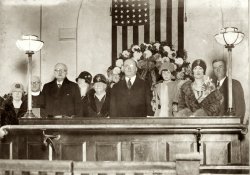
- Bar Car: 1955
- September 1955. Lloyd's Neck, Long Island, New York. "Arden field trials for spaniels." 35mm Kodachrome by Toni Frissell for ... Posted by Dave - 09/14/2023 - 3:46pm -
![Bar Car: 1955 September 1955. Lloyd's Neck, Long Island, New York. "Arden field trials for spaniels." 35mm Kodachrome by Toni Frissell for the Sports Illustrated assignment "Sporting Look: Field Trip at Marshall Field's Long Island Estate near Cold Spring Harbor." View full size.
Action, pleaseThis could easily be a still from a forgotten comedy with Doris Day and Rock Hudson. In one second, Rock and his friend, played by Tony Randall, will enter the frame and a wacky situation will develop quickly.
Non-Bar CarLeading the way is a green and white 1954 Buick.
Car bottleMy dad always kept a car bottle in the trunk, and I now do, as well. But neither of us had a setup like this!
MoviesMovie I think of re this scene is "Man's Favorite Sport" with Rock Hudson and Paula Prentiss.
Bar CarA 1955 DeSoto is bringing up the rear with the good stuff! Booze, cigars, cigarettes, cars (and maybe some guns). What can possibly go wrong?
Booze in the TrunkMy uncle had a little liquor suitcase like that, about half that size. When I would travel with his family, he wold pull it out in the hotel room and make himself a martini or two (or three). It had all the ingredients and a shaker too. His brother, my father, didn't drink, probably because of his older brother's booze fueled escapades when they were younger.
What can go wrong with an Old Fashioned?Just press the button marked B for Booze.
Park HereSix years later this Marshall Field estate became a New York State Park. It is called Caumsett State Historic Park Preserve.
https://parks.ny.gov/parks/23/details.aspx
Ain't no party like a Lloyd's Neck partyGuns, cars, and alcohol. What could go wrong?
The License PlateIn those days, New York State would issue new license plates, with new numbers, to each vehicle every two years. The color scheme would be reversed, so one year you'd have orange ("gold") plates with black numbers, which would be replaced by black plates with orange numbers. It was a real pain having to change those plates and send the old ones in (the screws tended to rust badly), so by the mid-'60s the state began issuing stickers, and you would put them on the old rear plate. You weren't supposed to turn in your plates until they became unreadable.
Now part of Caumsett state parkI grew up less than 5 miles from here. The Marshall Field estate house is now part of Caumsett State Park. It's a nice place for a walk.
CaumsettOne of the largest (1700+ acres) of the Gilded Age Long Island estates, Caumsett (as the Marshall Field estate was known) is now a state park occupying a third of Lloyd Neck:
https://parks.ny.gov/parks/23/details.aspx
Top of the Line DeSotoThe bar-car is a 1955 DeSoto Fireflite.
The Fireflite was introduced in 1955 to be the premium DeSoto model. The model was built until 1960 when the DeSoto brand was discontinued by Chrysler Corporation.
[We actually can't be sure what model this is. The script next to the taillight says "PowerFlite," the name of DeSoto's automatic transmission. - Dave]
SI in the 1950s - Documenting a different worldSports Illustrated used to cover hunting and card playing (a lot). Watching others play sports was a much smaller part of life back in the day, it would seem.
It's Field Trials for spanielsFor all you people saying firearms and guns what can go wrong. It's just field trials on pointing out ring neck pheasants for hunting dogs. There are NO firearms involved at this event.
[Um, no. Field trials involve shooting and retrieving. - Dave]
I beg to differ Dave …No firearms no hunting license visible. Any responsible hunter does NOT mix alcohol and ammunition.
[Can you not read? Can you not see the photos accompanying the article about this event? Hello?? - Dave]
What could go wrong?Guns, alcohol, cars (and tobacco, besides)- what could go wrong? Fortunately, this was Long Island, not Harlan County, Kentucky.
Shooting involvedThe dogs were retrieving birds shot down to order. I did enjoy reading this for the colorfulness of the language and for the emphasis on testing the dog: “The dog stopped instantly, dropping to his haunches, and sat marking the game bird’s flight, every muscle aquiver with intense eagerness. ‘Ride it out,’ signaled the judge, and the gunner held his fire in recognition of the request for a ‘long fall.’ At the crack of the gun, the pen-raised bird crumpled and slanted down into the high cover which bordered the woods, foretelling the difficult retrieving task for which the judge had hoped.”
Black and White Scotch whisky Makes sense to drink that for people who like dogs.
My mistake.Read? Yes. The article? No ... I based my postings on the bar car picture and missed the 'read article here' Begging for a thousand pardons Dave.
(The Gallery, Kodachromes, Cars, Trucks, Buses, Dogs, Toni Frissell)](https://www.shorpy.com/files/images/SHORPY-03362a.thumbnail.jpg)
- On the Radar: 1952
- ... airfield? View full size.
Idlewild Airport - New York City Based on the location of the radar antenna and the runway ... Posted by Dave - 11/11/2014 - 1:48pm -
![On the Radar: 1952 September 1952. "Man in an airport control tower looking at radar screen." From photos by Phillip Harrington for the Look magazine assignment "International Airport." Who'll be first to locate this anonymous airfield? View full size.
Idlewild Airport - New York CityBased on the location of the radar antenna and the runway configuration depicted on the radar screen it appears to be a view of Idlewild Airport in New York City. It was renamed to JFK airport after Kennedy was killed in 1963.
The two runways that form the "X" are long gone now but the other runways depicted are the part of the current runway infrastructure. Here is a 1951 runway diagram for the airport.
Ground Radar Device
New York Times, September 17, 1952.
Idlewild Airport Dedicates Tower
The tallest airport control tower in the world was formally dedicated and put into operation yesterday at New York International Airport, Idlewild, Queens. The structure, equivalent to an eleven-story building, is 150 feet high; with its ground radar antenna, 166 feet. …
The tower is unique it its location with respect to runways. It is the only tower completely surrounded by runways, with its nearest runway 1,900 feet away. This was necessarily so, it was said, because of the airport’s size, 4,900 acres, the largest in the world.
Because of its height, the structure will not infrequently be in or above the “stuff.” To aid the C.A.A. controllers under these conditions, the Federal Government has installed a ground radar device that gives the controllers an image of virtually everything on the ground in the immediate vicinity of the airport. The device, an experimental model, was borrowed from the Air Force for experimentation. Thus far the results have been satisfactory. …
Today's Kennedy InternationalUnless it's changed since I retired two years ago, Kennedy International (former Idlewild) has four active runways. 31L&R, 4L&R and their reciprocals. Parts of the old runway system may have been incorporated into the taxiways, but it's not obvious. Operated there hundreds of times.
SSDD (Same Screen, Different Day)FAA is still using those 50s-vintage oval screen CRTs, I believe
[The shape here is a circle, not an oval. - Dave]
Everyone is counting on himBut did he ever get over Macho Grande?
(Technology, The Gallery, Aviation, LOOK, Phillip Harrington)](https://www.shorpy.com/files/images/SHORPY-06605u.thumbnail.jpg)
- Up in Smoke: 1919
- New York circa 1919. The producer, playwright and director Stuart Walker, who had ... negative. View full size.
Odd Choice of Rug for a New York Playwright Am I really the first one to comment on the swastikas on ... Posted by Dave - 09/11/2011 - 8:30pm -
![Up in Smoke: 1919 New York circa 1919. The producer, playwright and director Stuart Walker, who had a long career in theater and film, spending a quiet night at home tossing scripts into the fire. George Grantham Bain Collection glass negative. View full size.
Odd Choice of Rug for a New York PlaywrightAm I really the first one to comment on the swastikas on this rug?
They are backwards swastikas (I think). They predate the Nazi era by at least 15-20 years.
I think I heard something about the swastika being an American Indian symbol for peace or something.
Decorating Faux PasGuess that rug wouldn't be a popular home decor accessory in a few years from when this picture was taken, all thanks to a certain bunch of Germans... It's amazing how many people think the swastika originated with the Nazis.
How cozy.Interesting motif on the fireside rug.
Interesting Indian RugVery interesting geometric designs on that rug, especially at the corners. Otherwise, it seems like a pleasant homey scene.
Fireside rug motif..very interesting!
Interesting rugLooks like an Indian rug from the Southwest. Those aren't swastikas, they're the four corners of the universe, I think. Or the Navajo called it the "whirling winds".
What's withWhat's with the swastika rug design Adolf??
Carpet For SaleTwenty years or so later, the Indian patterns on his rug would mean something so very different!
Nice swastikasProducer, playwright, director... and Nazi? Or is this a case of the older, perhaps Hindu, use of the symbol?
Lucky rugNotice the swastikas on the rug, which were considered good luck symbols and certainly ubiquitous before its subsequent notoriety.
Are they Swastikas?When one gets as old as I am, one's brain file is so crammed full of facts that we tend to be unable to remember things we learned. I do know that I did learn about the origin of the swastika, but in 1919 it was not yet a Nazi symbol. It might have been an early American Indian symbol but it had a different meaning than it does now. Also, that is not a very safe fireplace, it is an accident waiting to happen. Maybe he was destroying manuscripts he disliked since shredders were not yet invented.
I love the swastikaI love the swastika rug.....must be from Asia, and is a symbol of good fortune since Nazis came later.
"Good Luck" SwastikasStuart Walker's hearth rug is a nice tourist-quality Navajo wool rug of the sort that could be purchased in Santa Fe train station gift shops throughout the Southwest, as well as in East Coast department stores. From about 1895 to about 1930, Native American swastikas were a popular mainstream American "Good Luck" symbol, and were often paired with horseshoe and even shamrock motifs as good luck charms. Americans were also familiar with the many Chinese "Good Luck" swastikas seen on imported carpets, wood carvings and vases.
During this period the silversmiths Daniel Low & Co., of Salem, Mass., manufactured thousands of small sterling silver swastika charms for bracelets, earrings, pins and watch fobs, which sold quite well in Low's mail-order catalogs. Almost all American "Good Luck" swastikas disappeared with the start of World War II, and the terrible meaning of the Nazi swastika has erased these harmless "Good Luck" swastikas from our collective memory.
Now I knowNow I know why I never was published. What can I say?
RuggedIt's almost certainly a Native American, probably Navajo, rug. I'm pretty sure the design in the center part is still used on them. And yes, if it was still around 20 years later that rug probably went in the fire, too.
Unfortunate designThe first thing I noticed were the swastikas on the rug, but then I noticed the date in the caption. Strange how history can change the way we view things that were once commonplace.
Interesting Swastikas....There are Swastika's in each corner of the carpet and the main emblem looks like a derivative. I wonder if it is an East Indian rug.
They Runed ItIt's very sad, the way the Nazis usurped the swastika. The Nazis were very much into paganism, and used many pagan runes for their symbols as well.
Floor covering designThe kitchen floor covering in my grandmother's old home was factory printed with swastika symbols. I think it was installed in the 1920's.
Navajo RugThe one poster was exactly right that this is a Navajo rug woven by hand using wool from sheep raised by the family and probably mostly natural dyes. It would be worth a couple thousand dollars in today's market, swastikas notwithstanding.
A little about the swastikaThe swastika exists in more cultures than just Native American or Hindu. Further, it's not so much that the Nazis were into paganism, but that they borrowed signs of power from a variety of cultures to symbolize and encourage their own power. The swastika and double lightning bolts, as examples, are symbologically memorable and strong, which is why they appealed to the Nazis. Further, the Nazis altered the symbols slightly to make them *more* powerful and unique to themselves, such as turning the swastika 45 degrees so that it appears to spin, and the arms are going clockwise. There's a fascinating chapter about who chose which symbols for the Nazi party, and why, in the book Dictionary of Symbols.
Use of The Swastikawas so very common in design and in marketing. The Ladies Home Journal had a mail-in "Swastika Club" for young girls in 1910. Members got a swastika badge and materials teaching good homemaking practices. I think that the magazine had a monthly column aimed at members.
SpringtimeMax Bialystock searches for the perfect flop...
Pristine fireplaceThat's the most sparkling-clean fireplace I've ever seen. Any thoughts on whether this was a new home, a seldom-used fireplace, or whether Walker's housekeeper spent her days scrubbing bricks and mortar?
My mom has a large decorative garden urn which has been in her family since the 1920s and is decorated with swastikas. Needless to say, we've always felt it prudent to keep it in a spot where casual acquaintances don't see it.
[That might be asbestos board painted to look like bricks. - Dave]
NOT a swastika.The swastika is made from four backward 7s (an easy way to remember) but what you see in the pictures is, among other things, is a Native American symbol representing the thunderbird. NOTE: made from forward 7s.
[Incorrect. Swastikas can go either way; the Native American symbol is also a swastika. - Dave]
(The Gallery, G.G. Bain, NYC)](https://www.shorpy.com/files/images/28271u1_0.thumbnail.jpg)
- Joe's Clothes: 1942
- September 1942. "New York, New York. Under the Third Avenue elevated railway." Starring Joe's Clothes Shop ... Posted by Dave - 10/27/2023 - 5:27pm -
![Joe's Clothes: 1942 September 1942. "New York, New York. Under the Third Avenue elevated railway." Starring Joe's Clothes Shop and the Variety Theatre, which had a bit part in the movie "Taxi Driver." Acetate negative by Marjory Collins for the Office of War Information. View full size.
Cycle of the HoleNothing remains from this shot, except maybe - maybe - the block pavement (but if so it's buried under asphalt). The Variety went to that cutting room in the sky in 2005.
However, where the doughnut shop once stood, more-or-less, is now the "Bagel Belly". A Bagel shop in NYC? I'm guessing it's not the only one.
Sounds yummyI want to go to the Wheatland Doughnut Shop and Milk Bar.
Lawrence LoansBoy, would I love to browse that pawn shop on the right to check out all those stringed instruments showing in the window.
The Variety TheatreI grew up around there in the '50s and '60s, and I remember the Variety. It often featured live shows by old-school Jewish comedians who often performed in Yiddish. (There was a fellow named Ben Bonus who played there frequently.) That version of the Variety went away when the immigrant Jews in the neighborhood died off or retired away from Manhattan; their offspring weren't interested in that kind of entertainment.
The Variety booked some rock 'n' roll acts in the late '60s and early '70s, but the interior acoustics were terrible. That was also when the inside of the theater started smelling less like a movie house and more like a public urinal. It had become a dump.
[Also: Porn! - Dave]
Bagel Belly... is at 114 3rd Avenue, where Joe's and probably the doughnut shop was.
There is a film, c. 1983https://en.m.wikipedia.org/wiki/Variety_(1983_film)
The story centers around a woman who worked in the ticket box. It was reviewed in the Village Voice by David Edelstein. I commented on the review and he wrote back a response.
Just a wild guess1937 Buick.
Films at the VarietyI'd like to add that the last legit film I remember playing at the Variety was the first Matt Helm movie, which cast Dean Martin as a James Bond-type spy. It was The Silencers, released in 1966.
More VarietyThe Variety theatre also played a role in the 1983 independent feature Variety, directed by Bette Gordon and written by Kathy Acker - both of them leading counter-cultural figures at the time. Sandy McLeod, then Jonathan Demme's girlfriend, works in the box office of a porn cinema and becomes obsessed with a mysterious rich patron. The film is currently available on the Mubi streaming service.
(The Gallery, Marjory Collins, Movies, NYC, Railroads, Stores & Markets)](https://www.shorpy.com/files/images/SHORPY-8d08133u.thumbnail.jpg)
- Signs of the Times: 1942
- September 1942. "New York, New York. Looking north south on Broadway at Times Square." Acetate ... Posted by Dave - 10/26/2023 - 5:11pm -
![Signs of the Times: 1942 September 1942. "New York, New York. Looking north south on Broadway at Times Square." Acetate negative by Marjory Collins for the Office of War Information. View full size.
+69Below is the same view from April of 2011.
DirectionNo offense to the Office of War Information, but I'm pretty sure this is looking south.
[You are right ... Marjory Collins strikes again! - Dave]
What’s the deal with those parking rules?They seem bizarrely complicated.
Re: What's the deal?If I had to take a guess at the rationale behind those complicated parking rules, I’d say there’s no parking during the morning rush hour (7-10 a.m.), during the evening rush hour (5-7 p.m.), during the time when the plays begin (8-9 p.m.), then during the time when the plays let out (10:30-11:30 p.m.). Complicated, but at least not so bizarre.
Drastic changeSuch drastic changes to the Times Square district after 80 years. The New York Times basically moved from the Times Tower to 229 West 43rd in the 1960s where it remained until the 2010s when it moved to 620 Eighth Avenue. Now Times Square is primarily a tourist trap. Locals avoid it like the plague unless they have a Broadway show to see.
[The Times moved into its 43rd Street headquarters in 1913. - Dave]
Rush HoursThe evening parking restrictions are possibly for theatre dropoffs and pickups.
(The Gallery, Marjory Collins, NYC, WW2)](https://www.shorpy.com/files/images/SHORPY-8d08145a.thumbnail.jpg)
- The Curb Market: 1905
- New York circa 1905. "Broad Street exchange and curb brokers." 8x10 inch dry plate ... the Curb did when the weather got nasty, similar to what New York experienced this January?
Post Lux Mortem The crossbar is an ... Posted by Dave - 08/08/2012 - 2:03pm -
![The Curb Market: 1905 New York circa 1905. "Broad Street exchange and curb brokers." 8x10 inch dry plate glass negative, Detroit Publishing Company. View full size.
No barsHow did they ever get any business done? All of these businessmen, and not one using his cell phone!
What did she forget to tell him?Love the lady leaning out of the third floor window on the lower right to say something to the man who appears next to the lamppost, looking back up at her.
Hey JoeYou can meet my brother tomorrow afternoon on Broad Street. He'll be the one wearing the bowler.
No AutosIt's interesting that there don't appear to be any motorized vehicles in the picture. So far as I can see, everything is horse-drawn.
It appears to me that nearly all of the businessmen in the picture are wearing bowlers. For the most part, other hats, such as caps, are on younger men. Thus, I am guessing that the woman leaning out the window has sent the young man as a runner on some errand, and perhaps is, as coriander suggestions, adding something to the request.
The American Stock ExchangeThe "curbstone market" was the predecessor of the American Stock Exchange.
PeekingI love to see if anyone is looking out those windows ... Found one!
Lux MortemAwesome example of a Bishop's Crook Type #1 with crossbar. Today's reproductions are based on the BC type 24a, which look pretty close. But those globe luminaires hanging from the fluted fixtures are long, long gone.
What are we all looking at?It seems like there is a LOT of folks in the middle of the street doing something -- but what?
[Trading stocks. - Dave]
Au courantHere's the 1905 look, complete with a bowler hat..
And this is:Where I have all my money invested? Wish I would have seen this photo before my chat with an investment dealer.
Get that man a hat!I see you there to the left of the foreground globe... You think you can just stroll about in public half naked?
There's always one in the crowd!
One Hatless MaleAnd two women. Love the pic.
Neither Rain nor SnowGreat Photo! Does anyone know what the denizens of the Curb did when the weather got nasty, similar to what New York experienced this January?
Post Lux MortemThe crossbar is an artifact from the gaslight days, where the lamplighter would rest his ladder.
StandoutThere's one top hat (left foreground) vs 1,000 bowlers. Is this an executive? Mr. Peanut?
Nothing much changed by 1980I worked at 48 Wall Street for 16 years. Wall Street intersects at those steps at the top of the picture. That is where George Washington once spoke. Really, very little had changed. Most of those buildings were still there, and the crowd levels were the same. By 1975 crowds weren't playing stocks but 3 card monte that would scram when the lookout whistled.
Until about 1980 men with bowlers and tophats still walked the streets. They were carrying physical stocks and bonds between dealers. There was a 4 pm drop dead delivery for all transactions.
Hats off to youI'm reminded of the Simpsons episode where Homer ends up in the psych ward after wearing a pink shirt to the plant. The guys in lab coats were probably headed right for the poor hatless gentleman right behind the lamp bulb when this picture was taken.
Strange that a century later those wearing hats on a regular basis are the odd ones.
What are the vendors selling??I see apples and, what exactly? Parsnips? Carrots?
Topless on BroadPerhaps the crowd gathered are actually trading. Or maybe, when the man without a hat showed up, they all ran ran away from him, as if he were some strange alien, and are all discussing what they are going to do about this social deviant. Notice he's all alone there in the middle. Perhaps the man walking toward him (with something in his left arm...maybe a summons) will be the one to set him straight. "Sir, you need to put a hat on, or else. Get with the system, man."
A tale of two citizensA few paces behind the gent in the top hat is a fellow in working garb -- a lighter colored jacket that is open, with a different style hat.
And on the other side of the street, there is a fellow who is sitting on the railing, getting his shoes shined.
Three left standingActually only three of the buildings shown here are still standing: 1) The New York Stock Exchange of George B. Post (the pedimented building midway up the left side of the street), built in 1903; 2) the Subtreasury, aka Federal Hall National Memorial, originally the US Custom House (the partially visible Greek temple at the corner of Wall Street), built by Town and Davis, 1833-1842; and 3) the Broad Exchange Building, second from the right, built by Clinton & Russell in 1900. Everything else you see has been torn down and replaced by newer buildings.
[The poster below was speaking of the 1970s. - Dave]
You could hear a pin dropI worked on the Staten Island Ferry on weekends in the early 70's. The whole area was a ghost town when business was not in session. I remember the sound of a windblown rope hitting a flagpole that you could hear from blocks away.
The Third LevelSo few women, it looks like the Egyptian demonstrations. Only 100 and a few years ago, some of our grandparents just kids then, but the cityscape is overwhelmingly male (except for a few women selling fruits and vegetables from the carts). Are the men actually purchasing vegetables to bring home for supper? There's one man in the foreground on the left smoking a cigarette, while the man next to him has his hand up to his face like he is using a cellphone. Or making a gesture of some kind ("Hey, can you spare a smoke?") Of course, this could be a Jack Finney time traveler who forgot he isn't supposed to bring his cellphone and that not only do cellphones not work on planes, they don't work when you take the Third Level either.
Fruit CartsIf you're wondering what those carts are all about, they are selling fruit, not vegetables, to the brokers, who often didn't have time for a proper lunch. Instead, they'd grab a couple of apples or bananas, etc., and go back inside for more trading.
(This comment from food historian Jane Ziegelman)
ToucheI wonder what put a smile on the faces of the two men at bottom left, who btw look very much alike. Brothers? The bear of a man in centre front of the milling throng seems to be looking at the photographer.
SlapstickI got to thinking about all those discarded banana skins that seem to be in the gutters, on the road and doubtless on the footpath (sidewalk) in this photo. And wondered if this was a common sight in other locations where the fruit vendors plied their trade. Is this then the basis for the comical slipping on a banana skin routine? (BOBS).
A person slipping on a banana peel has been a staple of physical comedy for generations. A 1910 comedy recording features a popular character of the time, "Uncle Josh", claiming to describe his own such incident:
Now I don't think much of the man that throws a banana peelin' on the sidewalk, and I don't think much of the banana peel that throws a man on the sidewalk neither ... my foot hit the bananer peelin' and I went up in the air, and I come down ker-plunk, jist as I was pickin' myself up a little boy come runnin' across the street ... he says, "Oh mister, won't you please do that agin? My little brother didn't see you do it."(wikipedia)
Top 5This is truly a great picture but curious what makes it so popular that it has virtually become a permanent photo in the top 5? The last posted comment was on 2-19. Thanks for any info.
[Links from Stumbleupon and Reddit. - Dave]
Thought I would shareCute little moment they happened to catch.
Old Stomping GroundI love this 1905 photo and miss working at 25 Broad St (Paine Webber). I get a kick out of all the banana peels! Guess Peter Coyote is correct, it's a perfect food.
(The Gallery, DPC, NYC)](https://www.shorpy.com/files/images/4a12608a.thumbnail.jpg)
- USS New York Burial at Sea
- The recent Shorpy photographs taken on the USS New York . (armored cruiser CA-2) have been of a lighter nature. The following ... Posted by William Christen - 07/26/2010 - 7:54am -
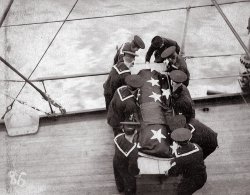
- New York Worlds Fair: 1964
- Shot of the Uni-sphere at the New York Worlds Fair in 1964. Taken from the sky ride. View full size.
... Posted by olegimpy - 09/18/2011 - 10:45pm -
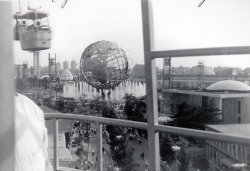
- Omnibus Stop: 1951
- ... June 1951. "Times Square street scene." Now playing at the New York Theatre: Skipalong Rosenbloom . 35mm acetate negative by Angelo ... Posted by Dave - 03/09/2021 - 11:47am -
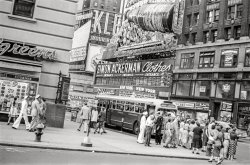
- Bernard Warner - New York City
- ... Father at approximately age 12. He had recently arrived in New York City from Ireland and I do not know the street where this photo was taken. ... Posted by BeckyF - 03/23/2012 - 11:49pm -
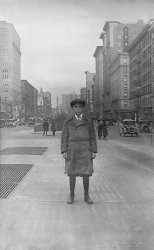
- Washday: 1900
- New York circa 1900. "Yard of tenement at Park Avenue and 107th Street." 11 x 14 ... could leave on those washday whites.
Real life in New York City Wow. Here's the world of my immigrant grandparents -- the ... Posted by Dave - 07/26/2012 - 4:57pm -
![Washday: 1900 New York circa 1900. "Yard of tenement at Park Avenue and 107th Street." 11 x 14 inch glass negative, Detroit Publishing Company. View full size.
Recalls Sam LevinsonThe Great Sam Levinson wrote of such a scene that his mother's nightgowns hung down a full three stories when wet, and his sister's skirts which "Dripped technicolor onto other people's whites"
PrecipitationRain must have made for an interesting day at work the next morning.
The GoldbergsThe lady in the upper left window has to be Mrs. Goldberg. She is getting ready to stick her head out the window and give us some words of wisdom.
No. 9My grandfather was section chief for the DM&IR Railway in Duluth, Minnesota. The company-owned house was directly next to the tracks, as these tenements are. My grandmother was fortunate to have her clothesline on the other side of the house. But I remember her hanging out to the schedule of the Number 9 coming out of the Range with a load of iron ore.
See the lady in the window? Maybe she sees King Kong!
Off line.Don't the people at the far end of the block do laundry?
Soggy soxIf putting your wash out on the line causes rain, there must be a hurricane headed for Manhattan.
The UnmentionablesWhat? No jockstraps or thongs?
Bombs Away!Imagine what marks some birds with digestive problems could leave on those washday whites.
Real life in New York CityWow. Here's the world of my immigrant grandparents -- the intimate backyard world. I love the details of the shirtwaist-wearing women in the top story apartment, whose child is out on the fire escape. And the folks around a table on the right hand side of the picture, one story down. They've got a plant on the fire escape and some other stuff -- it's like a balcony!
Wonderful picture - thanks Dave!
Solar poweredWhat a beautiful example of a "carbon footprint" this photo is showing. Not an electric clothes dryer in sight. Brings back memories of the postwar 1940s era. For some reason washday was always on a Monday, today's washday is a push of a button any day or time of the week.
Day of the weekMust be Monday!
OMG!What would today's NIMBYists have to say about this scene?
Yo ho, yo ho, a pirate's life for meIf a big enough gust hit, those building could go sailing off into the sunset.
Drip Drip DripI guess wash day was also No Playing in the Backyard Day!
I wonder why the train wasn't movingThere is no Metro North station (back then, "New York and Harlem" station) between 42nd Street and 125th Street, or at least there hasn't been for a long time. This photo was probably taken through the window of a train that had stopped on the tracks for some reason.
[This photo was made with a giant view camera (11 by 14 inch glass negative) on a tripod. It's not a snapshot from a train window. Detroit Publishing was a professional outfit. - Dave]
The HoneymoonersYou can almost hear Ralph yelling out the window at Norton
That carbon footprintOf course most of these clothes were washed in boiling water that had been heated on a coal stove. So that's a few tons of soot right there.
Make Mine ModernGracious me, it makes me grateful for the "carbon footprint" of my washer and dryer for it keeps other "carbon" life forms from not only seeing my unmentionables, bot those who might leave a little carbon signature of their own on them.
In my world wash day is whenIn my world wash day is when I can be sure of a good warm sunny day, or after the heaters go on, whenever i don't mind my lower floor of the house filled with wet hanging clothes. I don't know what folks did when it rained on wash day. I usually pay attention to the weather. If I do get rained out, fortunately there's still laundromats around with electric dryers. I do have a state-of-the-art front loader machine for the washing (anyone want my old maytag wringer?)
I refuse to get a dryer just as I refuse to add a dish washer, or get an air conditioner. One simply has to draw a line.
Hung out to dryMore interesting was watching the man who visited your backyard two or three times a year climb the poles to attach the clotheslines. "I climb poles" would echo through the yards. He charged around 25 cents for the climb and would sell lines and pulleys. If one planned ahead, the line and pulley would have been bought in the local hardware store for a small savings.
PS The roof was used for sunbathing (Tar Beach)
Marmoset or Flower Pot?Great photograph! Is that some sort of an animal on the window sill next to the top, far left?
Btw, I see some unmentionables on the lines, but of course I can't, er, mention 'em.
From roots like thisCouple years later, couple blocks south, couple blocks other side of those train tracks -- one of the kids playing under those clotheslines will be named Henry Louis Gehrig.
From Monday OnFrom Monday on, my cares are over
From Monday on, I'll be in clover
We picked on Monday because it's washday
And we'll wash our blues away
From Monday on, the skies will look bright
Don't tell me different, I know I'm right
I'm gonna start shouting Hey Hey
When he says Love Honor and Obey
I'll be happy, from Monday on.
A catchy late '20s Paul Whiteman tune with Bing and the boys singing about wedded bliss.
(The Gallery, DPC, NYC)](https://www.shorpy.com/files/images/4a28182u.thumbnail.jpg)
- Central Park, New York 1999
- I took this on my first trip to New York City in May 1999. A lot of photos were taken in my 4 days I was there, but ... Posted by mhallack - 01/04/2009 - 9:27am -
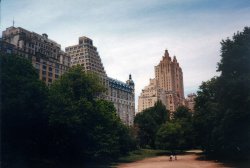
- Back the Invasion: 1944
- June 6, 1944. "New York. Part of the parade on D-Day, Madison Square." Medium format negative by ... were daredevils with a death wish. Especially in NYC!
New York City slickers Thank goodness I can finally get rid of this unsafe ... Posted by Dave - 08/09/2012 - 6:18pm -
![Back the Invasion: 1944 June 6, 1944. "New York. Part of the parade on D-Day, Madison Square." Medium format negative by Howard Hollem, Office of War Information. View full size.
Were there any anti-invasion people?I know during WWII this country had a very small minority of objectors but it's hard to believe at that time there would be any anti-D-Day people out counter-marching. Unless they were daredevils with a death wish. Especially in NYC!
New York City slickersThank goodness I can finally get rid of this unsafe rainwear and pick up some of the good stuff at the Safe Rainewear Co.
That's the Flatiron Building at the far rightThe Nic Nac, Freud Bar, and Adam Hat buildings are still there. The view looks to the SW from the SE corner of Madison Square Park.
View Larger Map
Who Were They?Any idea what group this was? There seem to be quite a few draft-age men in it: what looks like "ime" and a ship's wheel on the banner makes me wonder if it might be some sort of maritime or merchant marine union.
[National Maritime Union of America - CIO. - Dave]
That Nurse better be carefulThere are Rogue Sailors going around sweeping Women off their feet and kissing them hard on the lips.
Mayor's D-Day CommitteeThe next morning, the New York Times reported on the events surrounding a rally held on June 6 near the Eternal Light at Madison Square Park, featuring clergy and rabbis, singers of the major allied nations, and of course Hizzoner, Mayor LaGuardia. It also described the work of members of the "Mayor's D-Day Committee" in publicizing the rally through leafleting.
Bar sign is still thereThe bar sign for Metro Bar is still prominent as a sign for the Live Bait Restaurant and Bar. Either it's the original or an identical one.
Check out that AmbulanceWhat model of truck was that ambulance? I never saw one with a window in the shape of a cross! Much more stylistic than utilitarian.
"Good Like Nedick's!"Nedick's had a superb orange drink that could never be duplicated and the hot dog on a toasted bun was a special treat. When Mom bought you a "dog and an orange" you knew she loved you dearly. On the radio when the Knicks sank a basket you'd hear announcer Marty Glickman exclaim, "Good like Nedick's!"
Nic-NacNic-Nac is now a Quiznos, the Metro Bar is now Live Bait, a Cajun themed bar/restaurant. The building that housed The Safe Rainwear Co and those to the west of it were destroyed by fire October 17, 1966. Twelve firemen died fighting the blaze.
1944New York City police used Plymouth coupes, white on the top and dark blue-green on the bottom. The one in this picture looks so good to me. That bus type was used on the cross towns.
Safe Rainwear Co connectionFunny that Jon commented on the Safe Rainwear Co. - That was actually my wife's grandfather's store. He hailed from Poland, emigrating to Italy in the 1930's, finding himself an Austrian wife (also originally from Poland) and settling down in Rome. Just prior to the start of WWII he prudently realized it was time to say goodbye to Hitler's Europe and emigrate to the US. With his wife and two (soon to be three) small children in tow, he embarked on a 2 1/2 year long journey which took them through France, Cyprus, Spain, and Portugal, finally arriving in NYC in 1941. Not speaking a lick of English when they got here (although they both spoke multiple languages), they quickly achieved English proficiency, and opened up this store on 23rd Street. Over the years he opened up several stores in NYC, including one down on Nassau street. When his son (my father-in-law) took over the 23rd street store, he changed the name to "Victor's", and eventually sold the store in the early eighties.
Update: Talking to my father-in-law yielded the origin of the name "Safe" rainwear - his father concatenated the first two letters of his and his wife's first names (Samuel and Sadie) and last name (Feiwel).
(The Gallery, Howard Hollem, NYC, Patriotic, WW2)](https://www.shorpy.com/files/images/SHORPY_8d36280u.thumbnail.jpg)
- Meet the Yardleys: 1970
- ... party is on Bontecou Road at Lilburn Drive in Stony Point, New York. While a number of you independently arrived at the correct answer, Johnny ... Posted by Dave - 11/29/2022 - 4:26pm -
![Meet the Yardleys: 1970 UPDATE: Our garden party is on Bontecou Road at Lilburn Drive in Stony Point, New York. While a number of you independently arrived at the correct answer, Johnny Yuma was first. Clapclapclap! Tell us how you did it.
An unlabeled Kodachrome from the same batch of slides as young Stephen, fast-forwarded to what seems to be around 1970. Who'll be the first to Street View this split-level suburb? In the meantime, pull up a chair. View full size.
The Date?First warm day of Spring!
Late in the DecadeI'd bump the year forward a bit, to '68 or '69, judging by the polyester doubleknit and slingback shoes. Also the car next to "Stephen" is probably a model year later than '65. The younger man could conceivably be Stephen, at the age of 31 or 32. Definitely the first warm day of spring, though--an occasion worthy of pearls!
To Heck With Ralph NaderI'd love to have that red first-generation Corvair convertible in my driveway. Hopefully it's a four-speed turbo Spyder.
A clue?Hard to see on my work computer, but it looks like there's an address over the garage door of the house on the left. (Whose owner had excellent taste in cars!)
[Blurrily I say to thee: "Three Lxxxburn Drive." - Dave]
Temporal LocationI think the year could be 1967. The gold convertible in the background, with the black top, is a 1967 Chevelle, and the gold car in front of it looks to be a '67 full-size Chevy. There's also a red early Corvair convertible (it looks like a '62) with optional bumper guards parked in the neighbor's driveway, and what looks to be some kind of Mopar parked next to it (maybe a '65 or '66 full-size Plymouth).
I love... everything about this picture. From the old man's socks to the beer glasses (and the bottle of Schaefer), to the dresses to the split-foyer house across the street. The tray, the chairs, the ... everything.
Are we having fun yet?It will take more than a few of those Schaeffer beers to get this party started. Maybe a little music, a few jokes and invite all the neighbors over. (BYOchair). So far we have only one smiler.
Parents, mother-in-law, wifeStephen's looking a little worse for the wear, alas.
Raised ranchDon't know about the architechtural style of the other houses (can't see enough of them), but the house with the Corvair in the driveway looks like a "raised ranch," also called a "split foyer."
Possibly 1967The cars in the street appear to be 1967 Chevrolet models. The mostly hidden car looks like a '67 Impala SS and the convertible with the top up could be a '67 Chevelle. The Impala body style was new for '67 and the Chevelle was new for '66.
What is it?Behind the "Corvair house" up an incline or hill there appears to be a single home. What the heck is that appearing between it and the "Corvair house?" It appears to be a possible rock formation, but it looks as if it might have a door in it.
[The door or opening is in the lowest portion of that structure on the hill. -tterrace]
The YardleysTwo months prior, they were the Snowdons.
Sing alongSchaefer is the one beer to have ... when you're having ... more than one!
30 Bontecou Road, Stony Point, New YorkI do believe this is it. I found it using different letter combinations with the clue you provided. Took about 15 minutes to hit the right one. Google maps did the rest.
Found it!They are in Stony Point, NY.
The split foyer's address is 3 Lilburn Drive.
The house they are at is on Bontecou Road.
Better screenshotHere's a current shot including their house.
3 Lover's Lane?I thought it might be Lover's Lane, but couldn't figure the number. Maybe it's 3 Lovers Lane?
Clue possibly solved?Just registered as not only do I find this site fascinating, but discovered where the picture was taken (and itching to post my findings).
I tracked down the house in the background as No.3 Lilburn Drive, Stony Point, NY. The "Yardleys" quite likely lived at 30 Bontecou Road.
Party BottleMagazine advertisement, Schaefer Beer, 1967.
Five o'clock somewhere!I applaud the Shorpian sleuthing efforts here, and I especially applaud the Yardleys for the getting the party started so early in the afternoon!
Raised Ranch CityIn 1962 my family moved to Stony Point, NY. into, yes, a raised ranch just a hop, skip and a jump from this very neighborhood. In those days just about every new development in the 60's in Stony Point consisted of raised ranches (with an occasional split level) erected rather rapidly on what was once revolutionary era farmland. When we arrived one only needed to dial 4 numbers to telephone within the town. The town was transformed between 62-70, and that soon ended. Judging by the length and style of the dresses on two of these women, I also think this is more likely the late 60s.
This picture is a big hitI shared the Yardley pic on the Stony Point FB page. Of course, before long people who actually knew the name of the Happy Hour family started posting and sharing memories about the neighborhood. Seems that barn up on the hill (Stony Point is extremely hilly) was the starting point for some serious daredevil sledding. Can there possibly be more shots from the area in the batch? Hope so!!
(Cars, Trucks, Buses, Stephen Kodachromes)](https://www.shorpy.com/files/images/SHORPY-MSC002A.thumbnail.jpg)
- Grandfather in New York
- ... Hungary) Modern Vending Machine C. 312-314 E 22 nd str. New York. View full size.
(ShorpyBlog, Member Gallery) ... Posted by erzsierzsi - 01/27/2012 - 11:08pm -
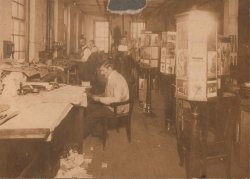
- New York City
- Taken on boat to Liberty Island, late 40s early 50s.
(ShorpyBlog, Member Gallery) ... Posted by mhallack - 07/29/2021 - 11:49am -
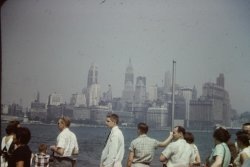
- Now Arriving from New York City
- My Grandma and Grandpa arriving in Chicago, maybe? Late 40's Kodachrome. View full size.
Prop planes When I was a kid I love to go to the airport and watch those big prop planes fire up. The trill has never been the same with jets. ... Posted by delworthio - 09/22/2011 - 7:35pm -
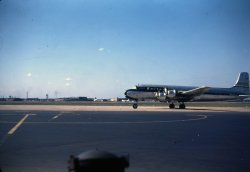
- The Ansonia: 1906
- Circa 1906. "Ansonia Apartments, Broadway, New York City." 8x10 inch dry plate glass negative, Detroit Publishing Company. ... Posted by Dave - 07/30/2012 - 4:35pm -
![The Ansonia: 1906 Circa 1906. "Ansonia Apartments, Broadway, New York City." 8x10 inch dry plate glass negative, Detroit Publishing Company. View full size.
HorsepowerThe electric van was state of the art, but the horse was still around for a couple of decades. Looks like some "road apples" in the street.
Where are the people?New York City, and not a single person in the shot? How?
[There are at least two people in this time exposure, visible as they paused by the curb, with hints of a third across the street. The faster walkers might not register at all. - Dave]
Wow!What a beautiful building!
Top floor, please!I want to buy the penthouse suite in the tower shown in the middle. What an AWESOME place!
Only in New YorkThe 1975 movie "The Sunshine Boys" featured the Ansonia as the home of the character Willy Clark, played by Walter Matthau. It had become a rundown has-been and the movie showed it that way. In that same period the Ansonia housed the storied swingers club Plato's Retreat in its basement. Plato's followed a former tenant, the Continental Baths, where a little known Barry Manilow accompanied an unknown Bette Midler entertaining its gay male audience. Today it is a luxury condo where a three-bedroom apartment is currently listed at $3.1 million.
Birthday cakeIt looks like a giant confection. Beautiful building.
Roof FarmLovely idea:
There was (...) a farm on the roof. It’s true: Stokes had a vision of a self-sustaining building, a kind of rental utopia. He purchased various farm animals and constructed a mini-pasture on the roof. Each morning, a staff member would deliver fresh eggs and milk to the guests or tenants of the building.
And there was even a cattle elevator (for dairy cows)!!
I wonder why did the department of health close it in the 1930s, and if it's possible to reopen it? Or has it since been replaced with AC boxes & .. ?
But yes, great building!
Beautiful buildingI took voice lessons from a man who rented out one room of a large Ansonia apartment for that purpose about 20 or 25 years ago. The building was in moderately sad condition then, but it still had a grandeur and style that was palpable. The apartment was huge and elegant, just like a Hollywood movie apartment, but of course needed some serious updating. The Ansonia has lost a couple of its elegant neighbors in the last few years, and on the next block up there's a very modern building that's an obvious tribute to it.
I believe the late New York City mayor John Lindsey lived there for many years, didn't he?
It's such a fine structure that it still provides the architectural anchor for the whole neighborhood.
Window WasherThere appears to be a window washer on the 12th fl balcony; I wonder how much he made!?
Mr. Mel stole my commentI can add only that early tenants of the building included Babe Ruth, Jack Dempsey, and Arturo Toscanini. When the building was new, they kept live seals in the fountain in the lobby. However it required enormous upkeep and decayed with stunning speed between about 1950 and 1980. There was a period of time when you couldn't open a New York newspaper without reading of some rent strike at the Ansonia or lawsuit by the people living there against the owners. It seems finally to have quieted down in the last few years, and the building is gorgeous, even nicer in real life than in that photo.
(The Gallery, DPC, NYC)](https://www.shorpy.com/files/images/4a12615a.thumbnail.jpg)
- East Side Story: 1905
- New York circa 1905. "Exterior of tenement house." Another view of the building on ... real estate. People love the huge doors, I guess.
New York Observer Could that woman in the window above the entrance be the ... Posted by Dave - 08/21/2012 - 12:00pm -
![East Side Story: 1905 New York circa 1905. "Exterior of tenement house." Another view of the building on East 40th Street seen here. 8x10 inch glass negative. View full size.
I like the carriagehouse next doorIt's been gone for decades, I'm sure. The few remaining carriagehouses in the city are hotly contested real estate. People love the huge doors, I guess.
New York ObserverCould that woman in the window above the entrance be the lady in the previous shot of this building?
[Note that there are at least three upstairs window-gazers here. Kind of a theme for today's posts! - Dave]
Trading StampsI didn't know that Green Stamps dated that far back. I always thought they were a new thing in the 1950s and '60s.
Another lost artNot much call for Ornamental Plasterers any more.
Family and Unescorted WomenI noticed the FAMILY ENTRANCE. I found this mentioned in a couple of my travel guides of Chicago during this era. From what I was told this was because unescorted women and children were not to use the front door. The main entrance would be on Main Street and the Women's and Family Entrance would be on a side street.
Yoo hoo, Mrs. GoldbergReminds me of the early 50s television sitcom (arguably the first ever) "The Goldbergs." Who can ever forget the refrain of Mrs. Kramer, calling out to her neighbor through open windows, "Yoo Hoo, Mrs. Goldberg!" One has to wonder about the utility of the balconies on the center building as a means of escaping fire. They have no stairs or ladders to the street.
Not Here NowI have to say this of 40th Street and 2nd Avenue. There isn't a Saloon on any one of the 4 corners.
Present East 40th StreetDoesn't appear that anything is left
S&H Green StampsS&H Green Stamps (also called Green Shield Stamps) were trading stamps popular in the United States from the 1930s until the late 1980s.
By the way: I love your "titling capacities" Dave!
Lofty Rental I am wondering what those lofts were going for back then and what they would go for today if they were still there. At 1625 square feet of floor space they would bring a pretty penny today.
Old BillI wonder if that is Bill Inwood suspecting that Green Stamps are maybe not the way forward after all!
LocationI'm guessing that that is the 3rd Avenue El that can be seen at the extreme right edge of this photo, which would place this block between 2nd and 3rd Avenues, and probably shows the south side of the street. If so, I believe that an access street originating from the Queens Midtown Tunnel now empties its traffic onto East 40th at just about the same location. It is just two blocks west of what is now Tudor City. Have I got the geography correct?
[As noted in comments under the other photo, the grocery is 308 East 40th Street. - Dave]
Ouch!Ouch! what's that lady sitting on by the grocers?
HoneymoonersI fully expected to see Ralph Kramden looking out one of the windows.
Apropos of nothingI seem to be at that stage of life where, on some days at least, the front page of Shorpy seems far more relevant than the front page of the New York Times.
Everything But MoneyLove this photo as it reminds me of Sam Levenson's great memoir, Everything But Money. There's a whole neighborhood in one building.
Since We're CountingI believe I see four window-gazers, although two could be ghosts!
Look at Me NowThe building below, as seen from First Avenue & 40th Street, is 300 East 40th Street, also known as the Churchill. This high-rise stands on the southeast corner of Second Avenue and East 40th Street, where 308 East 40th Street, the subject of this Shorpy image, used to be. It is a co-op building with some apartment prices ranging in the multiple millions. It is one of the few apartment houses in the city with an open air Olympic size swimming pool on its roof.
(The Gallery, DPC, NYC, Stores & Markets)](https://www.shorpy.com/files/images/4a20847a.thumbnail.jpg)
- On the Mend: 1900
- New York circa 1900. "Group of patients, Brooklyn Navy Yard hospital." 8x10 inch ... look very close to what most men are wearing today.
New York Observer Fellow in white at the top of the stairs.
Represented ... Posted by Dave - 08/14/2012 - 11:13am -
![On the Mend: 1900 New York circa 1900. "Group of patients, Brooklyn Navy Yard hospital." 8x10 inch dry plate glass negative, Detroit Publishing Company. View full size.
The Dry LookNot any greased-up or plastered down hair in this group. The hair styles look very close to what most men are wearing today.
New York ObserverFellow in white at the top of the stairs.
Represented vesselsSo far I've been able to make out the U.S.S. Newport, the New Orleans (front row seated rt. of center), and the Yankee (second row far right) and what I think is the Cincinnati (back row center). Front row seated third from left and second row fourth from right are sailors on which ships?
[U.S.S. Vesuvius. - Dave]
The Newport was a gunboat, the New Orleans was a cruiser, the Yankee was an auxiliary cruiser.
50 years before my time butThe blue uniforms are about the same with piping and 13 button pants. Several are probably boatswain mates because of their pipe lanyards. One may be a marine and another an officer. The guy in blue on the right gets the respect of everybody. And a couple may have have been in the Civil War.
YensI suddenly have an overwhelming craving for Crackerjack.
SpookedI was in the Brooklyn Navy Yard about 10 years ago as a software rep servicing a client. The place was a vast ghost town of many different and unusual decaying buildings, and apparently a haven for crime. They wouldn't let me walk around alone and I had to check my car from the window every hour or so. Some of the remaining buildings that were in passable shape were being used for small businesses. If the walls could talk that place would still have my ear.
Looks like a ventriloquiston the right side of the photo!
House DetectiveDarkman lurking under stairwell.
Comic ReliefCheck out the ventriloquist act on the right.
See also: Sick Bay 1900We saw at least a couple of these guys here. In particular, you can't miss the guy with the bandage around his head.
13 Button TrousersLooks like these guys were no more fastidious about doing up all the buttons than I was when I used to wear them. The ships USS New Orleans and USS Newport were involved in the recent conflict with Spain.
Big Bluejacket on the rightThere was a guy on my ship who looked a lot like him. We called him the Abominable Seaman.
Pasted In?It looks like the face of the young man in the white jacket, center second row, has been physically pasted in, note the distinct ring around the head.
[That's a bandage. Next question! - Dave]
Uniform VariationThe wide variety of uniforms and uniform items is notable. The three stripes at the end of the sleeve denote seaman first class, two denote second class. The shoulder watch mark on the seated SN - fifth from left in whites - reveals that he is assigned to the port watch.
Those lanyards may be knife lanyards.
Early versions of the dixie cup cover sometimes lacked sufficient stitching to stay in place - hence the floppy appearance.
Cuff PipingThree rows of piping was standardized on the blue collar in 1876..
Cuff piping was used to identify rank until 1947. Three rows identified Petty Officers, along with their "Crow"
Guy far rightis sitting on the next guy's knee!
It's a real wonderHow they kept those flatboard hats on their heads! Checkout the guy in the center, that a real "old salt."
Where is swee'pea?I yam what I yam, and that's all I yam.
The HulkThe fellow standing on the far right looks like someone no one would want to mess with.
Represented VesselsU.S.S. Vesuvius was a dynamite cruiser, a not very successful experiment.
(The Gallery, DPC, Medicine, NYC)](https://www.shorpy.com/files/images/4a14990a.thumbnail.jpg)
- Loop the Loop: 1903
- Circa 1903. "Loop the Loop at Coney Island, New York." Watch out for pickpockets. Detroit Publishing Company glass negative. ... Posted by Dave - 08/20/2012 - 10:22am -
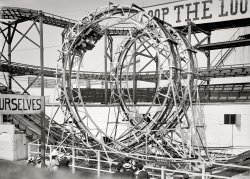
- Little Italy: 1900
- Little Italy circa 1900. "Mulberry Street, New York." 8x10 inch dry plate glass negative, Detroit Publishing Company. View ... Posted by Dave - 05/09/2020 - 6:49pm -
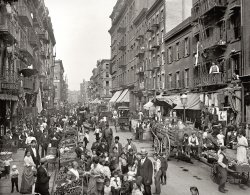
- Bon Voyage: 1903
- New York, 1903. "R.M.S. Majestic -- outward bound farewells." 8x10 inch dry ... from its wharf is the R.J. Barrett, built 1893 at Athens, New York, by Peter Magee for E.E. Barrett & Company, a prominent New York ... Posted by Dave - 10/08/2023 - 8:33pm -
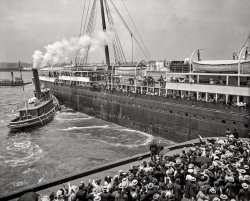
- Sightseeing New York: 1901
- This photo mounted on heavy card stock was found in a box of old family photos; it might be a souvenir. Probably taken in warm weather as the ladies have short sleeves and spring-like hats. Note this is Bus #4. I'm posting it to complement other ... Posted by ChasZ - 05/03/2013 - 7:20pm -
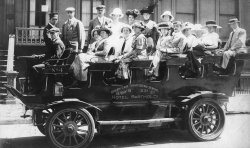
- 8-Inch Guns: 1900
- Circa 1900. "U.S.S. New York , crew of forward 8-inch guns." 8x10 inch glass negative by Edward H. ... had people that did the laundry, this is either a cruiser(New York city) or a battleship (New York state)this is most probably a cruiser ... Posted by Dave - 12/28/2012 - 10:16am -
